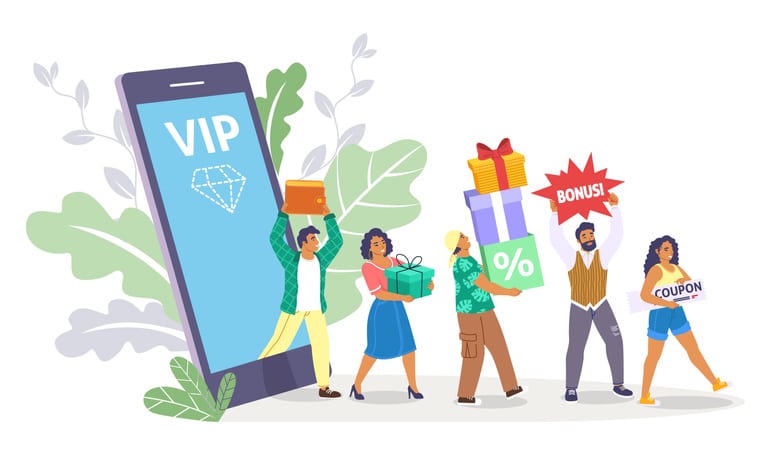The Power of Customer Loyalty Programs in E-Commerce
Introduction
In the competitive landscape of e-commerce, building and maintaining a loyal customer base is a strategic imperative. Customer loyalty programs have emerged as powerful tools for businesses to foster long-term relationships, enhance customer retention, and drive sustainable growth. This blog explores the significance of customer loyalty programs in e-commerce and provides insights into creating effective and engaging loyalty initiatives.
The Impact of Customer Loyalty Programs
1. Enhanced Customer Retention
2. Increased Customer Lifetime Value
3. Differentiation in a Crowded Market
Key Elements of Effective Customer Loyalty Programs
1. Clear and Attainable Rewards
Additionally, it's important to regularly communicate the benefits of the loyalty program to your customers through multiple channels such as email, social media, and in-store signage. This will help to ensure that they are aware of the rewards available to them and can easily see the value in participating in the program.
Furthermore, consider conducting surveys or gathering feedback from your customers to understand their preferences and what rewards would be most appealing to them. This will allow you to tailor the loyalty program to better meet the needs and desires of your target audience, increasing their motivation to participate.
Moreover, it's crucial to regularly review and update the rewards offered in the loyalty program to keep them fresh and exciting. This could involve introducing seasonal promotions, limited-time offers, or partnering with other businesses to provide unique and exclusive rewards to your loyal customers.
2. User-Friendly Program Structure
Design a user-friendly program structure that is easy to understand and navigate. Complicated or confusing loyalty programs may deter participation, so simplicity is key.
3. Personalization and Customization
By tailoring rewards to individual customer preferences and behaviors, businesses can create a more personalized loyalty experience. This approach allows companies to utilize data insights to offer targeted incentives that are more meaningful and relevant to each customer. As a result, customers are more likely to engage with the loyalty program and feel valued by the brand. This personalized approach can also help businesses build stronger, long-lasting relationships with their customers, ultimately leading to increased customer retention and loyalty.
Types of Loyalty Programs in E-Commerce
1. Points-Based Programs
In addition to encouraging repeat business, the points system also fosters a sense of loyalty between the customer and the company. As customers earn points with each purchase, they feel a sense of investment in the brand and are more likely to continue patronizing the business. This can lead to long-term relationships with customers and a higher customer retention rate. Furthermore, the ability to redeem points for discounts or free products gives customers a tangible reward for their loyalty, creating a positive and rewarding experience that keeps them coming back.
2. Tiered Loyalty Programs
Tiered loyalty programs are an effective way for businesses to incentivize and reward their most loyal customers. By offering different levels of rewards, such as exclusive discounts, special access to events, or personalized customer service, businesses can create a sense of exclusivity that encourages customers to stay engaged with the brand. As customers progress through the tiers, they are not only rewarded with increasingly valuable benefits, but they also feel a sense of achievement and status, which further strengthens their loyalty to the brand. This sense of progression and exclusivity can also lead to increased customer retention and lifetime value, as customers are motivated to continue engaging with the brand in order to reach the next tier and unlock even more rewards. In this way, tiered loyalty programs can be a powerful tool for businesses to build and maintain a loyal customer base.
3. Cashback and Discounts
Additionally, cashback or discount programs can also help to build a sense of reciprocity between the business and its customers. By providing immediate rewards for their loyalty, customers are more likely to feel appreciated and valued by the company, further strengthening their connection to the brand. Furthermore, these types of programs can also incentivize customers to increase their spending in order to receive greater rewards, ultimately leading to increased sales and revenue for the business.
Implementing and Promoting Loyalty Programs
1. Seamless Integration with E-Commerce Platforms
Integrate your loyalty program seamlessly with your e-commerce platform. This ensures that customers can easily earn and redeem rewards during the checkout process, enhancing the overall shopping experience.
2. Prominent Program Promotion
Prominently promote your loyalty program across your website, social media channels, and marketing communications. Clearly communicate the benefits and rewards to attract customer interest and participation.
3. Targeted Email Campaigns
Utilize targeted email campaigns to communicate with loyalty program members. Send personalized emails highlighting their progress, announcing exclusive offers, and reminding them of available rewards to keep them engaged.
Overcoming Challenges in Loyalty Program Management
1. Balancing Costs and Benefits
Challenge: Balancing the costs of running a loyalty program with the benefits it provides can be challenging.
Solution: Regularly evaluate the program's performance, adjusting reward structures and costs to maintain a healthy balance between customer satisfaction and business profitability.
2. Keeping the Program Engaging
Challenge: Sustaining customer interest and engagement over the long term can be challenging.
Solution: Continuously refresh and update your loyalty program to introduce new rewards, challenges, or exclusive events. Keeping the program dynamic ensures ongoing engagement.
3. Ensuring Data Privacy and Security
Challenge: Collecting and managing customer data for loyalty programs raises concerns about privacy and security.
Solution: Implement robust data protection measures, clearly communicate your privacy policy, and ensure compliance with data protection regulations. Building trust is crucial for loyalty program success.
Measuring the Success of Loyalty Programs
1. Customer Retention Rates
Monitor customer retention rates among loyalty program members compared to non-members. A higher retention rate among program participants indicates the program's effectiveness.
2. Repeat Purchase Frequency
Analyze the frequency of repeat purchases by loyalty program members. A successful program should encourage customers to make more frequent purchases, contributing to increased customer lifetime value.
3. Customer Satisfaction Surveys
Conduct customer satisfaction surveys specifically targeting loyalty program members. Feedback from participants can provide valuable insights into the program's strengths and areas for improvement.
Future Trends in Customer Loyalty Programs
1. Integration with Augmented Reality (AR)
Anticipate the integration of augmented reality (AR) experiences within loyalty programs. AR can offer interactive and immersive elements, enhancing the overall engagement and rewards experience for customers.
2. Blockchain for Loyalty Points
Explore the use of blockchain technology for loyalty programs. Blockchain can enhance security, transparency, and traceability of loyalty points, providing a more secure and trustworthy program.
3. Social and Environmental Impact Programs
Expect an increase in loyalty programs with a focus on social and environmental impact. Customers are becoming more conscious of the brands they support, and loyalty programs that contribute to charitable causes or environmental initiatives can resonate strongly.
Conclusion

Customer loyalty programs are invaluable tools for e-commerce businesses seeking to build strong, lasting relationships with their customer base. By understanding the impact of loyalty programs, implementing effective strategies, and staying attuned to emerging trends, businesses can create programs that not only drive customer retention and repeat business but also contribute to a positive and memorable customer experience. Stay tuned for more insights into e-commerce trends and business best practices in our upcoming blogs.


